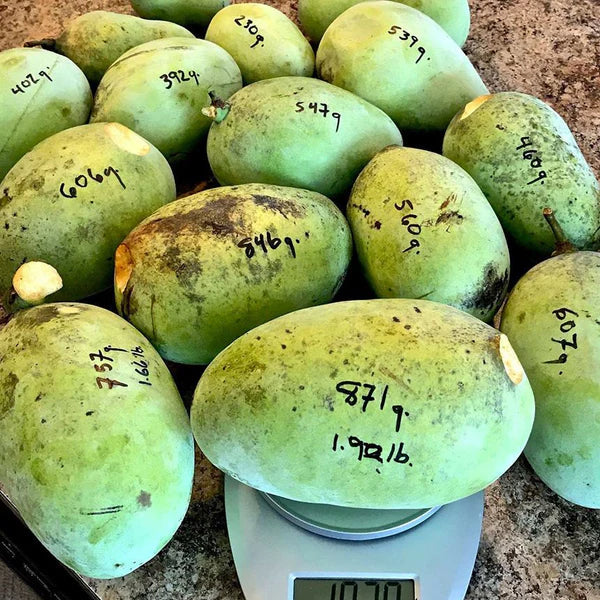Love it? Add to your wishlist
Your favorites, all in one place. Shop quickly and easily with the wishlist feature!
[message]
[title]
[message]


Veliyath Gardens
Couldn't load pickup availability
The American Pawpaw, scientifically named Asimina triloba, is one of the most captivating and lesser-known fruit trees of North America. Native to the eastern United States and extending into southern Ontario, Canada, this small deciduous tree has been an integral part of early American life, both nutritionally and culturally. With a flavor that seems born from a perfect blend of banana, mango, and caramel custard, the fruit holds a legendary status in Appalachian folk traditions, and its revival today is capturing the imagination of fruit lovers across the globe.
Botanical Name: Asimina triloba
Common Names: American Pawpaw, Appalachian Banana, Indiana Banana, Hillbilly Mango
Regions Known: Widely recognized in the USA, Canada, and increasingly cultivated in Europe and Australia for conservation and culinary purposes
Indigenous Roots: Native American tribes such as the Shawnee and Cherokee consumed and preserved the fruit, considering it a seasonal delicacy
The American Pawpaw tree is a low-maintenance, deciduous species that naturally grows in shaded woodlands and riverbanks.
Type: Small to medium-sized deciduous tree
Height: Typically 4 to 10 meters when mature
Growth Habit: Pyramidal when young, later developing a spreading canopy
Foliage: Large, tropical-looking leaves turn golden-yellow in autumn
Soil Preference: Moist, fertile, and well-drained soil
Light Requirements: Prefers partial shade when young; thrives in full sun with age
Time to Fruiting: Begins producing fruit in 4 to 6 years under ideal conditions
Pollination Note: Requires cross-pollination with another tree for reliable fruiting
The pawpaw fruit is soft and large, with a custard-like texture and a unique tropical fragrance.
Appearance: Green to yellowish skin, ripening to brown; mango-sized
Texture: Smooth, creamy, custard-like
Flavor Profile: A luscious mix of banana, mango, and vanilla-caramel
Consumption: Best eaten fresh from the tree, or used in smoothies, puddings, pies, and ice creams
Traditional Uses: Native Americans sun-dried pawpaw pulp for storage, while early settlers turned it into preserves and fermented beverages
Its rich flavor and velvety mouthfeel make it a true treat, unlike any other fruit found in temperate climates.
Beyond taste, American Pawpaw is rich in bioactive compounds and offers a variety of wellness benefits.
Rich in Vitamins
Contains Vitamin C, Vitamin A, and several B-complex vitamins
Supports immune health and skin regeneration
High in Antioxidants
Contains powerful natural compounds known as annonaceous acetogenins
These are being researched for their anticarcinogenic and antitumor properties
Iron and Magnesium Source
Supports red blood cell formation and energy metabolism
Beneficial in reducing fatigue and supporting muscle health
Digestive Aid
High in dietary fiber
Natural laxative effect when consumed ripe
The fruit is especially valued in herbal and indigenous healing systems for its immune-boosting and potential cancer-fighting properties.
The pawpaw was once a staple fruit in American homesteads and was beloved by historical figures:
Native American Lore: Tribes like the Iroquois and Shawnee cultivated and exchanged pawpaw saplings
Presidential Favorites: George Washington reportedly enjoyed pawpaw fruits chilled as a dessert
Folk Songs & Stories: The fruit is memorialized in Appalachian folk songs, celebrating its wild abundance
Traditions: Rural families often planted pawpaw near homesteads for easy seasonal harvesting
Its cultural revival today is driven by heirloom gardeners and exotic fruit collectors who wish to preserve America’s botanical heritage.
The American Pawpaw is well-suited to tropical and subtropical gardens if planted in a sheltered and well-drained spot.
Watering: Consistent watering during dry periods, especially when young
Mulching: Helps retain moisture and regulate root temperature
Fertilizing: Compost and organic matter can support vigorous growth
Pest Resistance: Naturally resilient to many pests and diseases
Care Tips: Young trees should be shaded for the first two years, after which they adapt well to sunlight
Once established, this tree is remarkably self-sufficient and a low-effort addition to any fruit garden.
Shelf Life: Pawpaws are highly perishable; best consumed within 3 days of harvesting
Preservation Methods:
Frozen pulp can be stored for smoothies and baking
Dried slices are occasionally made for snacks
Fermentation: Traditional beverages and vinegars can be made from overripe pulp
With its tropical flavor, rich health profile, and deep cultural roots, the American Pawpaw (Asimina triloba) offers more than just fruit. It is a living piece of history and a botanical rarity that thrives quietly and gives generously. For home gardeners, it is a chance to grow something truly unique—an ancient fruit tree that nourishes the body and connects us with centuries of tradition.
At Veliyath Gardens, we are committed to introducing exceptional fruit species from around the world. The American Pawpaw Tree, with its creamy golden fruits and legendary reputation, is a true gift for garden lovers who value health, history, and harmony with nature.
Add a touch of North America’s hidden legacy to your fruit garden—let the magic of Pawpaw unfold on your own land.
Available now at Veliyath Gardens – your source for rare, healing, and unforgettable fruit trees.
Soil Preference: Moist, fertile, and well-drained soil
Light Requirements: Prefers partial shade when young; thrives in full sun with age
Time to Fruiting: Begins producing fruit in 4 to 6 years under ideal conditions
Rich in Vitamins
Contains Vitamin C, Vitamin A, and several B-complex vitamins
Supports immune health and skin regeneration
High in Antioxidants
Contains powerful natural compounds known as annonaceous acetogenins
This small deciduous tree has been an integral part of early American life, both nutritionally and culturally. With a flavor that seems born from a perfect blend of banana, mango, and caramel custard, the fruit holds a legendary status in Appalachian folk traditions.



